A variety with an appetizing name - “Strawberry” tomato: we grow it correctly and collect up to 5 kg per bush
The variety of tomato varieties and hybrids developed through selective breeding never ceases to amaze. Many gardeners have long abandoned conventional high-yielding varieties and switched to exotic crops that can captivate not only with their name, but also with their external decorative appearance.
Every summer resident wants to grow something unusual on his plot. The Strawberry F1 tomato belongs precisely to such hybrids: it captivates not only with the appearance of the fruit, exactly reminiscent of a sweet garden berry, but also with its excellent taste. Extraordinary sweetness with barely noticeable sourness and subtle fruity notes have made the hybrid almost a legend in the tomato world.
Description of the variety
The f1 hybrid was bred by Russian breeders and included in the State Register of Breeding Achievements. Recommended for cultivation in open ground and in greenhouse conditions. Adapts well to temperature changes and drought.
Distinctive features
Type indeterminate, height up to 1.5 m, dense foliage, large, bright green leaves.
Reference! The indeterminate type has no restriction on the growth of the main stem.
 An early-ripening hybrid, 90-95 days pass from the moment of sowing the seeds to full ripening.
An early-ripening hybrid, 90-95 days pass from the moment of sowing the seeds to full ripening.
The productivity is high, up to 5 kg of fruits are harvested from 1 bush, provided that 2-3 seedlings are planted per 1 sq. m. m.
The hybrid genes contain high resistance to many dangerous diseases of the nightshade family.
The culture requires mandatory gartering and pinching.To improve the fruiting rate, plants are formed into 1 trunk.
Fruit characteristics
Average weight is 20-50 g, the shape is not typical for a tomato: ripe vegetables resemble strawberries. The color is bright red. The taste combines spice, sugar, acid and light fruity notes. The pulp is dense, there are few seeds. The peel is thin, but the fruits do not crack during heat treatment.
Reference! Hybrid Strawberry is divided into two subspecies: orange and red tomatoes. The yellow-orange fruits have a richer sweet taste and are great for making salads and sauces.
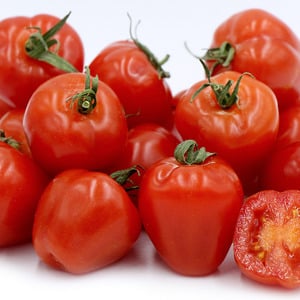 Ripe vegetables are consumed fresh: for preparing salads, various snacks, canapés; due to their small size, they are used for whole-fruit canning. They are not suitable for processing into tomato products due to their dense pulp.
Ripe vegetables are consumed fresh: for preparing salads, various snacks, canapés; due to their small size, they are used for whole-fruit canning. They are not suitable for processing into tomato products due to their dense pulp.
Tomatoes are subject to long-term storage and can withstand long-term transportation, which makes it possible to breed the crop for sale.
The photo shows Strawberry tomatoes.
How to grow seedlings
Sowing seeds for seedlings begins 2 months before planting in the ground. Before sowing, the seed undergoes special preparation.
Seed preparation
The grains are laid out on the table and carefully inspected for visible defects. Seeds suitable for sowing must be free from bending and damage. The emptiness of the grains is checked by immersing them in a saline solution, which is prepared from 1 teaspoon of salt dissolved in a glass of water. Those that floated to the surface after 10 minutes are not viable, which means they are not suitable for sowing.
Then the planting material is disinfected in a weak solution of potassium permanganate for 20 minutes. After disinfection, they are washed with running water.
To improve germination, seeds are soaked in a growth stimulator for 12 hours. The swollen grains are ready for sowing into the ground.
Reference! As a growth stimulator, in addition to specialized products, you can use melt water and aloe juice.
Container and soil
The soil is prepared from a mixture of garden soil, peat and washed river sand in equal proportions. The resulting soil is spilled with a hot solution of dark potassium permanganate for disinfection. Also, for these purposes, the soil can be steamed in the oven at a temperature of 50° for at least 15 minutes. When the soil has cooled, it is laid out in planting containers.
Plant in a common wooden box or in individual containers, for example, plastic cups or peat pots.
Reference! Growing seedlings in a wooden box is the cheapest way, and peat pots are the most expensive. However, many gardeners propagate seedlings in peat containers, avoiding later replanting into the ground and feeding the seedlings. The walls of peat containers contain many nutrients necessary for growth and development.
Sowing
Seeds are sown to a depth of 2 cm with a distance of 3-4 cm from each other. Then sprinkle with peat, level, moisten with warm, settled water using a spray bottle and cover the containers with film to create a greenhouse effect.
The containers are left in a bright and warm room at a temperature of at least +23. Periodically the film is removed for ventilation. The soil is moistened as the top layer of soil dries out with warm water.
Seedling care
When the first shoots appear, the containers are moved to a more illuminated place, on the windowsill, but not in direct sunlight.
Important! Under direct exposure to sunlight, young bushes receive serious burns.
Daylight for seedlings must be at least 16 hours, so there is a need to provide additional lighting with lamps. Some gardeners provide lighting to young bushes around the clock.
This type of seedling requires long daylight hours.
Water with warm, settled water as needed using a shallow watering can or a regular tablespoon along the edge of the containers, without flooding the soil. Overmoistening threatens rotting of young roots. After watering, the soil is loosened with a wooden stick, superficially, without touching the root system.
Reference! Loosening the soil promotes better penetration of oxygen to the roots.
After two true leaves appear, the seedlings are picked and placed in separate containers. If the seedlings are left in a common box, then increase the distance between them to 10-15 cm. When picking, weak plants are disposed of, since they will not survive in open ground. During picking, young bushes can be fed with liquid fertilizer for seedlings.
2 weeks before transplanting, the seedlings begin to harden by taking them out into the open air for 45 minutes. Gradually, the time spent outside is increased to 11 hours, while at the same time reducing the night temperature in the room to +13°.
How to grow tomatoes
After 2 months, the seedlings are ready for transplanting. If the soil temperature is less than +15, then planting in the ground should be delayed, otherwise the seedlings will not begin to grow for a long time, which will delay fruiting.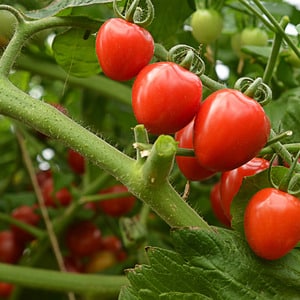
Landing
The Strawberry tomato loves fertile soil, so humus, wood ash and complex fertilizers are added to the soil.
Planting pattern: 40 cm – distance between seedlings, 60 cm – row spacing. For 1 sq.m place no more than 2-3 plants.
After transplanting, the holes are watered with warm, settled water and mulched with sawdust. Mulching helps retain moisture in the beds longer and prevents the penetration of many pests.
Further care for tomato Strawberry F1
Regular watering is established as young plants adapt to new conditions. Water infrequently, 1-2 times a week, increasing the number of waterings on dry days. It is important to avoid dampness in the beds. Tomatoes do not like excess moisture, and high humidity has a negative effect on developing fruits, giving them a watery taste.
After each glaze the beds are loosened, removing weeds with roots.
Reference! Weeds can be used as mulch. When rotting, it will feed the root system with additional beneficial substances.
Plants need feeding regularly. The fertilizer is a full complex of minerals, which is added to irrigation every 2 weeks. During the budding period, phosphorus and magnesium are added to the main fertilizing for healthy growth and development of plants, and during fruiting, potassium fertilizers are used for faster fruiting.
Features of cultivation and possible difficulties
When transplanting, vertical wooden or metal supports are installed next to each bush. Despite the powerful bush, the plant requires obligatory staking not only of the stem, but also of the fruit-bearing branches, since they cannot withstand the weight of ripe vegetables.
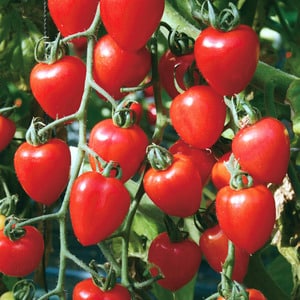 The ideal fixation option is a garter on a trellis. To do this, install supports at different ends of the bed and stretch wire between them.
The ideal fixation option is a garter on a trellis. To do this, install supports at different ends of the bed and stretch wire between them.
Tall bushes require regular stepsons, otherwise a lot of nutrients will be spent on the growth of unnecessary shoots. In addition, if the plants are not planted, there is a possibility that the plantings will become dense, which will lead to the development of fungal spores and the spread of insect pests.
For the greatest return, the crop is formed into 1 stem. This is a necessary condition for those who want to get maximum yield.
Diseases and pests
The hybrid is immune to diseases of the nightshade family. But for prevention purposes, it is recommended to carry out regular loosening and mulching beds, control of humidity levels and systematic ventilation of closed structures.
The influx of fresh air destroys not only the pathogenic environment, but also the habitual living conditions of many parasites, in particular the greenhouse spider mite.
Young bushes are susceptible to attacks by the Colorado potato beetle, which is why regular and thorough inspection of plants is so important. The beetle is collected by hand and burned in glass jars. If there is a lot of it, use the drug “Prestige”. But remember that the use of insecticides is possible only before the ovaries appear.
Advice. Planting sharp-smelling plants next to tomatoes will protect them from many ground and flying pests. Pheromone traps will protect against whitefly butterflies, and treating the stems with a soap solution will protect the bushes from slugs and aphids.
The nuances of breeding in greenhouse conditions and in open ground
Long daylight is a necessary condition for the full growth and development of the hybrid. To prevent the bushes from stretching out, select beds in a sunny, draft-free place.To protect the plants from wind and precipitation, install an additional support next to the bush, to which it is fixed immediately upon replanting.
 To limit the growth point, pinch the tops of plants. This procedure is especially important in greenhouse conditions, since the growth of greenhouse bushes is usually higher than outside.
To limit the growth point, pinch the tops of plants. This procedure is especially important in greenhouse conditions, since the growth of greenhouse bushes is usually higher than outside.
All lower leaves must be removed. With constant contact with wet beds, they can rot and cause the development of fungal diseases.
Since the crop needs fertile soil, it is necessary to remember the rules of crop rotation, which recommend planting tomatoes on the land where legumes, cabbage, carrots or winter crops were previously grown. After peppers, potatoes and eggplants, the tomato will lack nutrients, since previous crops greatly deplete the soil.
When planting in a greenhouse, the top layer of soil must be changed, and the new soil must be disinfected with a weak solution of potassium permanganate to destroy pathogenic flora. You can also treat with copper sulfate, which serves as a preventative against late blight.
Harvesting and application
Harvesting begins in early summer. Vegetables ripen together, in whole clusters.
Tomatoes are used mainly for preparing fresh dishes: various snacks, summer salads, baking, canapés, vegetable stews. Due to their dense pulp, small tomatoes are used for whole-fruit canning, where they perfectly retain their excellent taste. This type is practically unsuitable for tomato products due to the high dry matter content.
Ripe vegetables are subject to long-term storage and can withstand long-term transportation, maintaining their marketable appearance.For these reasons, the variety is bred commercially.
Advantages and disadvantages
Tomato Strawberry f1 has many positive characteristics:
- early ripening;
- good adaptation to temperature changes;
- drought resistance;
- immunity to many diseases;
- simple agricultural technology;
- high fruiting rate;
- excellent taste;
- unusual appearance;
- presentation for a long time;
- possibility of breeding for sale;
- preparations for the winter;
- long-term storage;
- long transportations.
The negative aspects include regular stepsoning and mandatory garter.
Other "strawberry" varieties
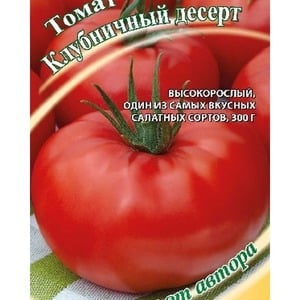 The Strawberry hybrid is not the only one of its kind, reminiscent of everyone’s favorite garden berry. There are other varieties with similar names.
The Strawberry hybrid is not the only one of its kind, reminiscent of everyone’s favorite garden berry. There are other varieties with similar names.
Tomato Strawberry Dessert
Indeterminate type, requiring obligatory gartering and pinching. The ripening period is average, it begins to bear fruit 120 days after sowing the seeds. Fruiting is extended, lasting until the first frost. Designed for breeding in greenhouse conditions.
The fruits are large, up to 300 g, red with a ruby tint. The taste of vegetables is excellent, richly sweet with a high content of sugars. The variety is high-yielding, at least 10 kg are harvested from 1 bush. There is increased resistance to diseases.
Tomato Strawberry Tree
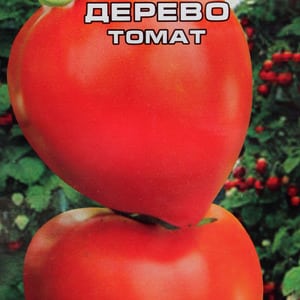 Indeterminate mid-early variety, begins to bear fruit in 100-110 days. It takes root equally well both in open ground and in greenhouses.
Indeterminate mid-early variety, begins to bear fruit in 100-110 days. It takes root equally well both in open ground and in greenhouses.
Productivity is high, from 1 sq. m harvest up to 12 kg of fruit. It is highly resistant to diseases such as tobacco mosaic virus, verticellosis, brown spot and cladosporiosis.
The culture requires mandatory gartering and pinching. Ripe vegetables of excellent taste, sweet with barely noticeable sourness, weighing up to 200 g.
Shrubs are often planted in front gardens; their form as a small ornamental tree can decorate any area.
Tomato German red strawberry
Semi-determinate, early ripening species, 100-115 days pass before fruit ripening. Recommended for open ground and greenhouse conditions. The variety is high-yielding, up to 7 kg of fruits are harvested from 1 seedling. Immune to most diseases.
Gartering and pinching plants is a mandatory procedure in tomato care. Unlike other varieties, the origin of tomato is Germany. Ripe fruits are large, 250-500 g, the taste is excellent, sweet, the color is deep red or orange. The culture can be propagated using both seedless and seedling methods.
Hybrid Cherry strawberry
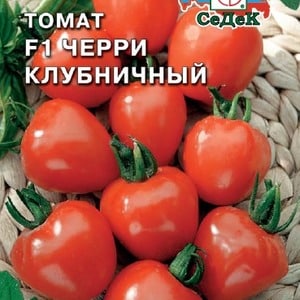 An early-ripening, medium-sized hybrid, recommended for open and protected ground. Fruits in 90 – 100 days. Immune to typical diseases of the nightshade family.
An early-ripening, medium-sized hybrid, recommended for open and protected ground. Fruits in 90 – 100 days. Immune to typical diseases of the nightshade family.
Productivity is high, from 1 sq. m harvest up to 9 kg. It is distinguished by the excellent taste of vegetables and their appearance: it is a copy of a strawberry.
The taste is sweet due to the high sugar content, the color is bright red. Tomato bushes, strewn with fruits, look like decorative decorations for garden plots.
Ripe vegetables are immediately put into processing, since they cannot be stored for a long time.
Farmer reviews
Despite the fact that the hybrid is relatively young, based on its favorable reviews, we can say that it occupies a leading position not only in summer cottages, but also in sales markets.
Olesya, Stavropol: "Wonderful hybrid! She led into 2 trunks, watered and fed.I was pleased with the harvest; there was enough for salads and in jars. Tomatoes are very tasty and beautiful. I’ll definitely plant more.”
Elizaveta, Omsk: “I plant strawberries in a greenhouse, the bushes never get sick, they stay healthy all season. The tomato is high-yielding, which I really like, since I make a lot of preparations for the winter. The tomatoes are very beautiful, they look great in salads and in jars. These are my favorite tomatoes."
Conclusion
An early-ripening hybrid with the ambiguous name Strawberry hides not only an attractive appearance, but also the unique aroma of an exotic berry. In addition, the tomato is resistant to low temperatures and drought, immune to many dangerous diseases and is highly productive. And caring for it is so simple that experienced gardeners recommend it even to beginners.